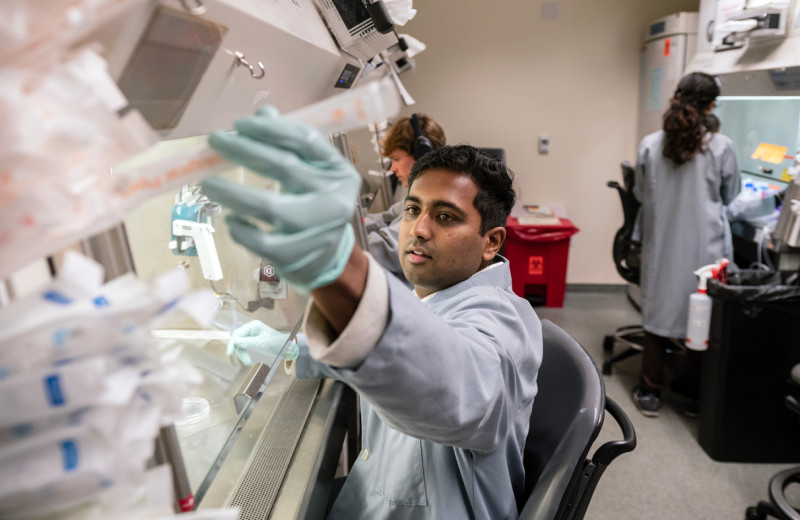Gladstone NOW: The Campaign Join Us on the Journey✕

Bruce Conklin, a senior investigator at Gladstone, studies human genetics that lead to cardiovascular disease. He received his medical degree from Case Western Reserve University, and completed his medical residency at Johns Hopkins and postdoctoral training in molecular pharmacology at the University of California, San Francisco. [Photo: Chris Goodfellow, Gladstone Institutes]
What brought you to Gladstone?
Coming out of my postdoctoral fellowship at Parnassus-UCSF, Gladstone was a great opportunity for me. Bob Mahley, Gladstone’s president at the time, challenged me to establish a research program with therapeutic implications that was distinct from my postdoctoral work. I was also impressed with Gladstone’s cores, which allowed me to use technologies that I previously had no experience with.
What do you like about Gladstone?
The motto “Science with a purpose” at Gladstone really rings true. I enjoy applying basic science to challenging biomedical problems. I have always been encouraged to take risks that moved my research closer to meaningful results in human health.
Were you interested in science as a child?
Yes, I loved animals. As a teenager in New Haven, I took care of a private collection of exotic animals that included primates (slow lorises, pottos), snakes (pythons, boas, pit vipers), scorpions, a monitor lizard, and an alligator. It’s hard to imagine anyone having this kind of collection now, but it was a dream job for me.
Why did you decide to go to graduate school?
As an undergraduate at Berkeley, I focused on public policy and public health. I went to medical school thinking that I would do primary care in East Africa. However, I soon found that I was not well suited for clinical medicine—I liked to spend so long with each patient that I was terribly inefficient. I enjoy diving deeply into problems, and that is better suited for a scientific career.
What or who influenced your decision to work in science?
When I first saw patients, I realized the enormous amount of disease that couldn’t be explained by our current knowledge. I became fascinated with the potential to discover new biology, but I had never worked in a lab. I decided to take some time off to see what research was like. I was fortunate enough to join the HHMI research scholars program at the NIH, which sponsored my research with Julius Axelrod (Nobel 1971). I have been hooked on basic research ever since.
What do you do when you are not working in the lab?
I enjoy many types of history (science, social, political, and evolutionary). We live at a time when the world’s history is at our fingertips.
I particularly enjoy traveling to parts of the world that provide unique perspectives. This summer, I traveled to Tanzania, where the evolutionary diversity and human history are fascinating.
If you could learn to do anything, what would it be?
It would be nice to be able to play a musical instrument. I have a profound lack of musical skills, but I do like listening to good music.
Name one thing that not many people know about you.
My father was an anthropologist, and I inherited his field station in the mountains near Banaue in the Philippines. It’s off the electrical grid, where the traditional animist (pagan) culture is still quite strong. While growing up, I lived at this field station for several years while my father did field work. My mother, Jean Conklin, documented this time in the field in a humorous way in her book, “An Ifugao Notebook.”
If you could meet any scientist from any point in time, who would it be and why?
It would be great to meet Gregor Mendel. As a Catholic monk, Mendel made remarkable new discoveries on the genetics of dominant and recessive traits. Interestingly, he made these discoveries in near complete isolation, and no one appreciated the importance of his work until 15 years after his death. If I had the opportunity to meet Mendel, it would be wonderful to tell him how important his research was.
The Genome Editing Playbook Is Different in Neurons
The Genome Editing Playbook Is Different in Neurons
The striking findings of a new study could influence how gene therapies are designed for many genetic diseases.
News Release Research (Publication) Neurological Disease Conklin Lab Doudna Lab CRISPR/Gene EditingCIRM Awards $7.5 Million in Discovery Grants to Gladstone Investigators
CIRM Awards $7.5 Million in Discovery Grants to Gladstone Investigators
Two ambitious research projects led by Gladstone investigators are boosted by funds from the California Institute for Regenerative Medicine.
Grants News Release Congenital Heart Disease Cardiovascular Disease Bruneau Lab Conklin Lab CRISPR/Gene Editing Human Genetics Regenerative MedicineScience in Seconds | Gladstone Researchers Tackle Charcot-Marie-Tooth (CMT) Disease
Science in Seconds | Gladstone Researchers Tackle Charcot-Marie-Tooth (CMT) Disease
Bruce Conklin and his team at Gladstone are tackling Charcot-Marie-Tooth (CMT) disease, the most common inherited neurological disorders—for which there is currently no cure.
Gladstone Experts Conklin Lab CRISPR/Gene Editing



